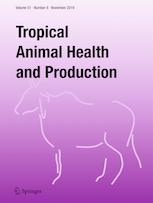Ver ítem
- xmlui.general.dspace_homeCentros e Institutos de InvestigaciónCICVyA. Centro de Investigación en Ciencias Veterinarias y AgronómicasInstituto de GenéticaArtículos científicosxmlui.ArtifactBrowser.ItemViewer.trail
- Inicio
- Centros e Institutos de Investigación
- CICVyA. Centro de Investigación en Ciencias Veterinarias y Agronómicas
- Instituto de Genética
- Artículos científicos
- Ver ítem
Generalized glycogenosis in Brahman-derived breeds: diagnosis and prevalence in Argentina
Resumen
Generalized glycogenosis is a lethal autosomal recessive disease caused by a deficient activity of the acidic 1,4-α-glucosidase enzyme and characterized by an accumulation of glycogen within lysosomes. Three mutations in the GAA gene causing bovine generalized glycogenosis have been identified in two cattle breeds, Brahman and Shorthorn. The objective of this study was to evaluate the prevalence of carriers of the E7 mutation in the GAA gene in
[ver mas...]
Generalized glycogenosis is a lethal autosomal recessive disease caused by a deficient activity of the acidic 1,4-α-glucosidase enzyme and characterized by an accumulation of glycogen within lysosomes. Three mutations in the GAA gene causing bovine generalized glycogenosis have been identified in two cattle breeds, Brahman and Shorthorn. The objective of this study was to evaluate the prevalence of carriers of the E7 mutation in the GAA gene in Argentinean Brahman-derived herds. A total of 930 Braford, 94 Brangus, and 8 Brahman samples were analyzed. The genotyping was done by polymerase chain reaction and restriction fragment length polymorphism (PCR/RFLP). We found that 12.02% (95% CI 12.00-12.04) of the total number of samples received were heterozygous (i.e., carriers) for the E7 mutation, while 12.58% (95% CI 12.56-12.60) of the Braford, 6.38% (95% CI 6.26-6.51) of the Brangus, and 12.50% (95% CI 9.82-15.18) of the Brahman samples were carriers of this loss-of-function allele. Neither breed nor sex were significantly associated to the presence of the mutation. The prevalence informed in this study is similar to the average prevalence reported for Australian Brahmans. The finding of heterozygous animals suggests that breeders and insemination centers should continue screening their herds to minimize the dissemination of this deleterious allele.
[Cerrar]

Fuente
Tropical Animal Health and Production : 1–6 (Agosto 2019)
Fecha
2019-08
Editorial
Springer
ISSN
1573-7438
Documentos Relacionados
Formato
pdf
Tipo de documento
artículo
Proyectos
(ver más)
INTA/PNBIO/1131033/AR./Genómica y biotecnología aplicada a la cría animal.
Palabras Claves
Derechos de acceso
Restringido
 Excepto donde se diga explicitamente, este item se publica bajo la siguiente descripción: Creative Commons Attribution-NonCommercial-ShareAlike 2.5 Unported (CC BY-NC-SA 2.5)
Excepto donde se diga explicitamente, este item se publica bajo la siguiente descripción: Creative Commons Attribution-NonCommercial-ShareAlike 2.5 Unported (CC BY-NC-SA 2.5)

